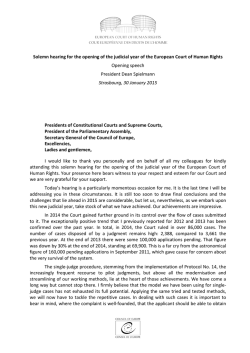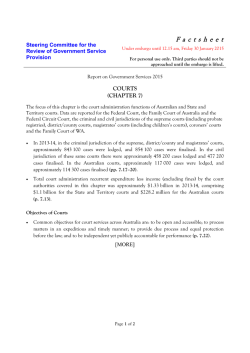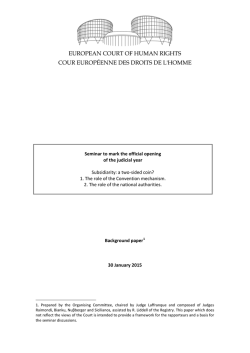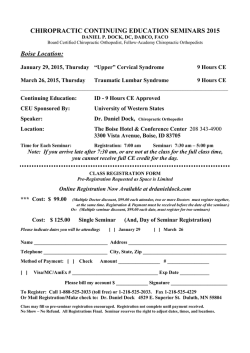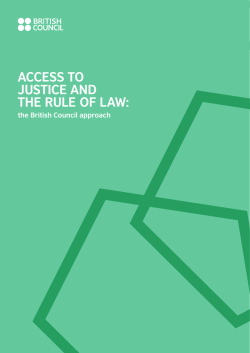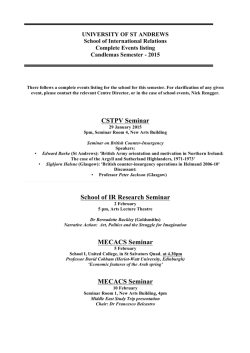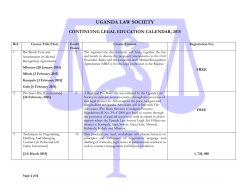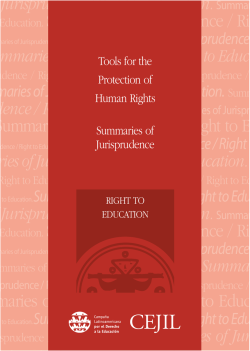
Seminar - European Court of Human Rights
Seminar Subsidiarity: a two-sided coin? 1. The role of the Convention mechanism 2. The role of the national authorities Opening speech President Dean Spielmann Strasbourg, 30 January 2014 Presidents, Ladies and Gentleman, Dear friends, I am very pleased to see so many of you gathered here today for our traditional annual seminar. Once again, your attendance illustrates your interest in this meeting between the European Court of Human Rights and the Supreme Courts of Europe. The presence amongst us of university scholars and Government Agents before the Court will, I am sure, contribute to the interest of the discussions this afternoon. I should like to thank Judges Raimondi, Bianku, Nuβberger, Sicilianos, Lemmens and Laffranque, who have organised the seminar with the assistance of Roderick Liddell. We are fortunate enough to have two speakers here this year whom I have no hesitation in describing as exceptional, and it is an honour for me to welcome them: they are Sabino Cassese, judge at the Italian Constitutional Court, and Jean-Marc Sauvé, VicePresident of the French Conseil d’État. They have been friends of our Court for many years. Every year our seminar gives us the opportunity to explore different aspects of the Convention system together. Last year we devoted our reflections to the implementation of the Court’s judgments, whereas today we are going to examine a concept which comes into play at a stage prior to European scrutiny and lies at the heart of the Convention mechanism. I am of course talking about subsidiarity. As you know, the term subsidiarity does not appear in the Convention. What it means is that the task of ensuring compliance with the European Convention on Human Rights falls firstly to the domestic courts, with the Court intervening only in the event of a shortcoming on the part of the domestic courts. Seminar – 30 January 2015 The judgments which refer to the subsidiary role of the Convention mechanism are very old, since the Court referred to that concept as early as 1968 in the Belgian Linguistic case. Since then the principle has been reaffirmed many times, to the point where it has become one of the keystones of our system. Subsidiarity is indeed at the heart of our relations with the national courts. At our bilateral meetings, be these in Strasbourg or the supreme courts, it is a central element of our discussions. It constitutes, in a way, a dividing line in the application of the Convention between the national courts and our Court. All this transpires from what we also call shared responsibility. This expression, which is more recent and is used increasingly frequently, is, fundamentally, only another way of talking about subsidiarity. The principle of subsidiarity is embodied in the obligation to comply with certain rules, including procedural rules, the primary one being the obligation on the applicant to exhaust domestic remedies. The Court must respect the autonomy of the domestic legal systems, but on condition that the domestic courts apply the Convention properly. In any event, the proper application of the principle of subsidiarity contributes to the effectiveness of the system, since the division of powers between the domestic courts and the European Court reinforces the primary responsibility of the domestic courts and contributes to conferring on the domestic courts the role of principal actors in the protection mechanism. Respect for the rights contained in the Convention is therefore ensured by different actors, who, each according to their own role, enrich and strengthen the protection of human rights. A corollary of subsidiarity is the margin of appreciation that leads our Court to impose limits on itself in the exercise of its scrutiny where it considers that the national authorities are better placed than the Court to resolve a dispute. However, whilst no one contests the merits of subsidiarity, we know that the margin of appreciation has its advocates and its critics. As our friend Laurence Burgorgue-Larsen recently lamented, in one of her insightful articles, “the national margin of appreciation is everywhere”, including in Protocol No. 15. I am sure that the question of the margin of appreciation will be discussed today. Lastly, the national authorities contribute to guaranteeing the proper application of the principle of subsidiarity, for example by providing for effective domestic remedies or examining the compatibility of draft laws with the Convention. The role that Government Agents may play in this respect is fundamental. As I said in 2014, at the opening of the judicial year, we are witnessing more and more often, in our relations between domestic and international courts, the replacement of the pyramid structure by a network system. Allow me to quote you, dear Jean-Marc Sauvé. In 2010, during a conference at the Conseil d’État, you looked back – and I quote – “without nostalgia on the charms of a bygone era in which the national judge lived in splendid isolation”. You are absolutely right: the national judge is no longer alone. Today the actors of subsidiarity are many and varied. Many of them are assembled here today, alongside legal commentators and bloggers. This therefore promises to be an occasion of rich and lively debate. - 2/3 - Seminar – 30 January 2015 I do not wish to delay so will now immediately give the floor to my colleague and friend Julia Laffranque, who has very kindly agreed to chair this seminar. Thank you for your attention. - 3/3 -
© Copyright 2024
